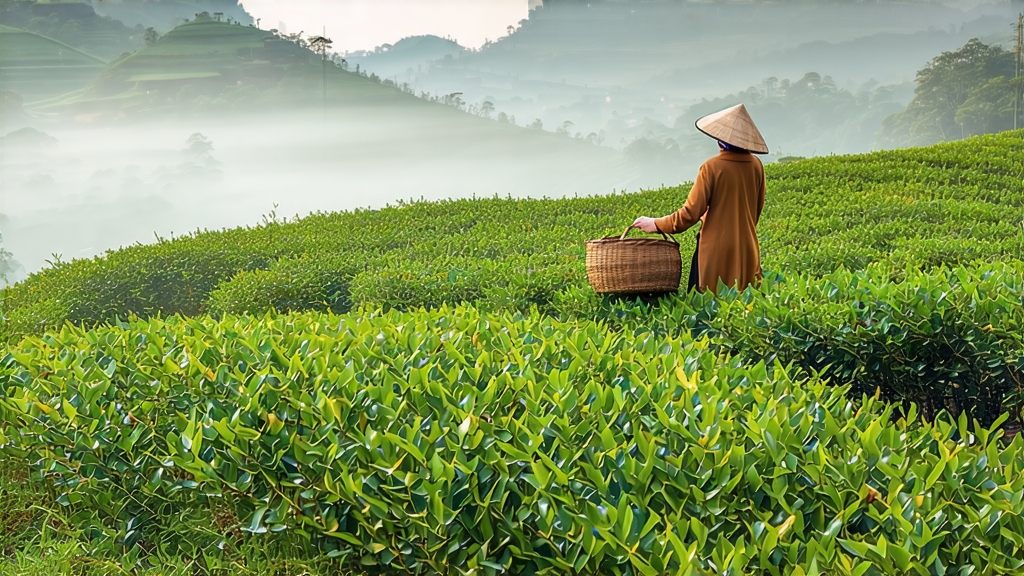
Tucked between the mist-laden cliffs of Dongting Mountain in Jiangsu Province and the vast, wave-washed surface of Lake Tai, Biluochun—“Green Snail Spring”—has captivated emperors, poets, and modern connoisseurs for more than a thousand years. Its name alone evokes the season of renewal: “bi” for the jade-green color, “luo” for the tight spiral that resembles a snail shell, and “chun” for the spring harvest that gifts the leaf its unparalleled fragrance. To understand Biluochun is to step into a living chronicle of Chinese horticulture, craftsmanship, and aesthetics, where every curl of leaf carries the perfume of apricot blossoms and the memory of mountain mist.
Historical whispers trace Biluochun’s origin to the Tang dynasty (618-907 CE), when it was first recorded under the humbler name “Xia Sha Ren Xiang”—“Scary Fragrance”—because its heady aroma startled tea pickers. Legend claims a tea picker ran out of space in her basket and tucked fresh leaves between her breasts; warmed by body heat, the leaves exhaled an intoxicating perfume that scented the entire mountainside. By the late Ming and early Qing dynasties, the Kangxi Emperor (r. 1661-1722) sampled the tea during his southern inspection tours. Enchanted, he rechristened it Biluochun, elevating it to gong cha (tribute tea) status and securing its place among China’s Ten Famous Teas.
Today, authentic Biluochun is narrowly defined: only leaf plucked within a 12-kilometer core zone on Dongting East and West Mountains qualifies for protected-origin status. The cultivar of choice is the small-leaf “Dongting Qunti,” an indigenous shrub whose tender buds yield higher amino acids and lower polyphenols, translating into the tea’s hallmark sweetness and low astringency. Two microclimates converge here—lake water moderates temperature swings while granite-rich soils drain quickly—forcing roots to struggle, concentrating flavor. Even the mountain’s fruit trees play a role; peach, plum, loquat, and apricot intercrop with tea, their spring blossoms showering nectar that settles on the downy buds, creating a natural “floral terroir” impossible to replicate elsewhere.
Harvest begins at Qingming (early April) when nights still dip to 8 °C and mornings arrive wrapped in fog. Only the topmost “single bud with one unfolding leaf” is taken, a pluck standard that yields 70,000 buds per 500 g of finished tea. Speed is ritual: leaves must reach the village workshop within two hours to halt enzymatic oxidation. There, a master with thirty years’ experience orchestrates a six-step choreography performed entirely by hand on a 200 °C bamboo-leaf-lined wok.
Withering is skipped; instead, the freshly picked leaf is “kill-green” (shaqing) immediately. The master tosses 250 g of buds onto the wok, his bare fingers reading temperature through touch. A rapid 3–4 minute high-heat phase deactivates leaf enzymes, fixing the green color. Next comes rou nian—“soft kneading”—where pressure is applied in concentric circles for eight minutes, rupturing cell walls to release aromatic precursors while coaxing the first tentative curl. The critical huo guo—“fire pot”—follows: temperature drops to 70 °C, and the tea is rolled against the wok’s wall in a figure-eight motion. Moisture escapes with an audible hiss; the leaf tightens into its signature spiral. A final low-heat drying at 50 °C for twenty minutes reduces moisture to 6 %, locking in fragrance. The entire process consumes 45 minutes, after which the tea rests for three days in unglazed earthen jars to “marry” flavors before packing.
The dry leaf is an objet d’art: tiny, furled snails no longer than 1.5 cm, downy with silvery trichomes that catch light like frost. Color ranges from jade to deep spinach; a faint bloom of white indicates optimal withering. Inhale, and the aroma is a layered chord—white peach, lychee, and a whisper of vanilla that comes from the leaf’s own methyl salicylate. When brewed, the spirals perform a slow ballet, unfurling vertically before sinking, a phenomenon locals call “the standing forest.”
Water choice is paramount. Ideal is spring water from the same mountain, low